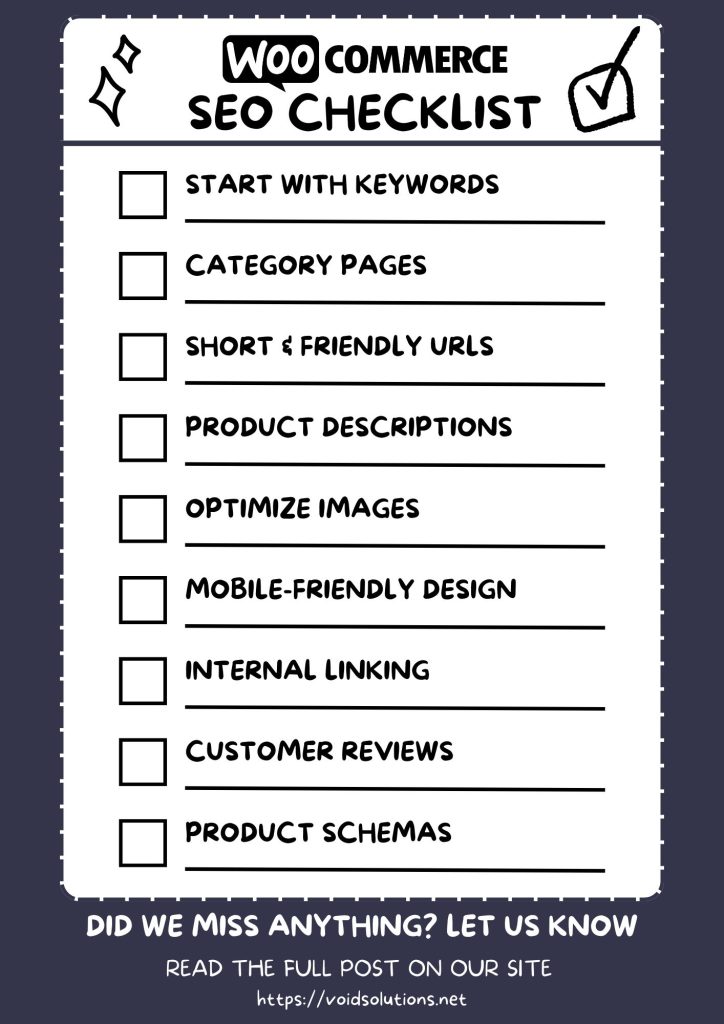Launching a WooCommerce store is like opening your dream shop – but on the internet. And much like a physical store, you need foot traffic to stay in business.
There is no foot traffic on the internet, what you’re after is organic web traffic which you gain by properly implementing a WooCommerce SEO plan.
We are a full-service agency with expertise in designing, developing, and managing WooCommerce stores for clients across the world. Get your free quote today.
Let’s dive into this short and concise SEO checklist for your WooCommerce business:

1. Start with Keywords

Imagine you’re your own customer. What would you type into Google to find your products?
We use tools like Google’s Keyword Planner, Google Trends, Ahrefs, Semrush and the good ol’ search suggestions to find the exact terms that people are using.
For a new website, you should focus on keywords that have at least 3 or 4 words in them. There will be less competition and you will have a better chance of ranking.
2. Don’t Forget about Category Pages
Category pages play a crucial role in guiding users and search engines through your website. These pages can often rank easily if you properly optimize them. They are typically more generalized yet still targeted enough to attract relevant traffic.
Think of your own browsing habits. If you were looking for a specific type of product, wouldn’t you start with a broad category? Your customers probably would too. This is also where keyword cannibalization comes into play.
Most businesses would not want a single pair of jeans to outrank their category page for a search term like “vintage jeans”.
3. Proper, Short, and Friendly URLs
Your URLs play a significant role in how search engines and users perceive and navigate through your website. URLs that are concise, descriptive, and easy to read can improve your SEO performance and provide a better user experience.
Consider what you would want to see if you were searching for your own products. Would you prefer a long, complicated URL with random numbers and characters, or a short, clear URL that tells you exactly what page you’re on? It’s a no-brainer!
Here’s some quick tips:
- Keep it simple: Aim for URLs that are short and to the point. Remove unnecessary words, but ensure they still provide a clear description of the page content.
- Use keywords: Incorporate your primary keyword into the URL. This helps search engines understand what your page is about and improves your chances of ranking for that term.
- Avoid special characters: Stick to using hyphens to separate words. Special characters and underscores can confuse both users and search engines.
- Stay consistent: Develop a URL structure that is logical and easy to follow. Consistency helps users navigate your site and allows search engines to crawl it more effectively.
- Do not change once indexed: Unless absolutely necessary, you should not change a URL once it starts appearing in SERPs and gains traction. Doing so would just harm your SEO!
1. www.example.com/category/product-1234/
2. www.example.com/shoes/running-shoes
Which one do you like more?
4. Use both Short & Long Product Descriptions
WooCommerce provides you with two types of descriptions for each product: the short description and the long description.
The short description usually appears next to your product images and the add-to-cart button. This section should be:
- Concise and compelling: Summarize the key features and benefits of the product. Keep it focused and engaging to capture immediate interest.
- Keyword-rich: Incorporate relevant keywords naturally to improve search visibility without compromising readability.
Think of the short description as an elevator pitch for your product—it should be enticing enough to make the user want to learn more or make a purchase.
The long description is typically displayed further down the page and provides more in-depth information about the product. Here’s how to make the most of it:
- Detailed content: Cover all the aspects of the product, including specifications, usage instructions, benefits, and any other relevant details that can help the customer make an informed decision.
- Structured format: Use headings, bullet points, and images to break up the text and make it easily scannable. This not only enhances user experience but also helps search engines understand the content better.
- Keyword optimization: Naturally integrate a variety of related keywords and phrases to capture long-tail search queries.
Pro Tip: Imagine explaining the product to a friend who’s on the fence about buying it – be persuasive and clear! Many users make up their mind about purchasing a product after reading the long description.
5. Optimize Images
This section is short, but it is probably the most important task on this list.
Ever waited for an image to load so long that you gave up? Everyone is impatient, and you should respect this fact by ensuring that your website loads as quickly as possible.
Compress images to ensure they load quickly, and don’t forget to use alt tags – these help search engines understand what’s in the image.
6. Mobile-Friendly Design
Over half of all web traffic comes from mobile devices. Actually, here’s a quick screenshot directly from our client’s analytics dashboard:

If your site isn’t mobile-friendly, you’re waving goodbye to a huge chunk of potential customers. Most WordPress themes are responsive, but always double-check using Google’s Mobile-Friendly Test tool.
7. Internal Linking
Think of internal links as the aisles in your store – they help visitors (and search engines) navigate easily from one product to another. Link related products together to keep people browsing longer. But also:
- Make sure that the most important category pages are all accessible from the top menu.
- Put links to other important pages in the footer, for example, categories by brand or specifications.
- You can also combine multiple relevant categories into a single page and highlight these pages on the footer & your store’s landing page.
8. Customer Reviews
Google loves fresh content, and customer reviews are like free content updates! Encourage happy customers to leave reviews; it boosts credibility and keeps content updated.
Customer reviews provide credibility as having social proof is important for online stores, you should try and display reviews right before or after the long product description.
Pro Tip: Set up an email campaign to automatically request feedback the first time a customer becomes a repeat-buyer – people are more likely to leave reviews when prompted.
9. Schema Markup
We managed to double our clients’ weekly clicks and impressions by working on their product schema. Think of schema as adding detailed tags to your store’s products – it helps search engines understand exactly what you’re selling.
Tools like Google’s Structured Data Markup Helper can guide you through this, or you can also reach out to us for a free consultation.
10. Monitor and Adjust
SEO isn’t something you set up once and forget about – it’s more like tending a garden.
You must consistently use tools like Google Search Console, Semrush, and ahrefs to monitor your traffic and see what’s working or what needs tweaking. It takes at least 6 months of effort to start ranking a website in a competitive manner – give or take a few months depending on how competitive your niche is.
- Track your site’s position for important keywords.
- Make changes and wait to see if your position improves.
- Keep writing and improving supporting content to improve your ranking.
Do you want to do your own SEO?
Optimizing your WooCommerce store for SEO doesn’t have to be an overwhelming task.
With the right guidance and a well-structured plan, you can significantly improve your store’s visibility and attract more organic traffic.
For those who prefer to take charge but need a roadmap to get started, we offer a one-time service: a 3-month SEO plan tailored specifically for your WooCommerce store.
Our plan will equip you with the essential strategies, tools, and insights you need to successfully manage and boost your SEO efforts on your own.
Ready to take control of your SEO journey?




